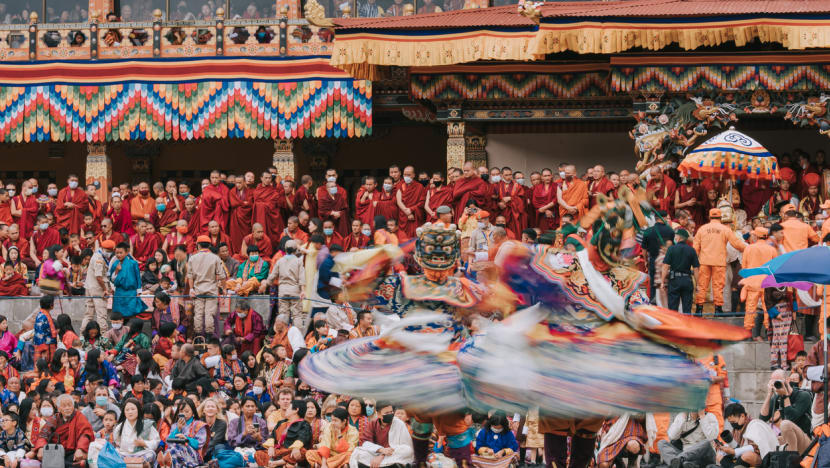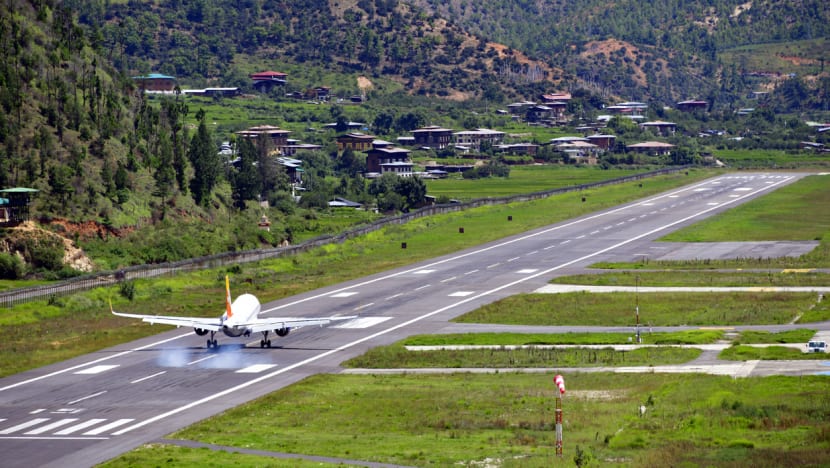Bhutan being hard to get to and expensive is a myth, says its PM
Bhutan aims to attract 300,000 tourists annually - an informal maximum set by the country to ensure that tourism does not impact its nature and environment.

Performers dance at Thimphu Tshechu Festival in Thimphu, Bhutan. (Photo: iStock/Edwin Tan)

This audio is generated by an AI tool.
Bhutan wants more tourists and it is working towards it. Among the country’s plans to make it a more attractive destination is improving accessibility, which may be standing in the way of its tourism goals.
More helicopters, wider roads, and a large international airport two years from now in the upcoming Gelephu Mindfulness City are in the works as the kingdom tackles lagging post-pandemic tourism numbers.
“The country is looking at one or two more land entry points from eastern Bhutan … so that we can spread people to other parts of the country,” Bhutan’s chief tourism officer Damcho Rinzin told CNA’s East Asia Tonight on Tuesday (Jun 11).
Today, visitors can only fly to Paro International Airport, which is located in the western part of Bhutan - over an hour away from capital Thimphu - and in the middle of a valley.

They then have to drive, take a domestic flight or helicopter to get to other parts.
Trying to disperse tourists into the eastern, central and southern parts of Bhutan also means needing to train locals to take part in the tourism industry, said Mr Rinzin. This could include facilitating homestays and conducting river rafting, he added.
“We told our people that every Bhutanese is a stakeholder of the tourism industry. So in that sense, we are trying to get everybody on board,” he said.
AIMING FOR 300,000 TOURISTS
Bhutan aims to attract 300,000 tourists annually - an informal maximum set by the country to ensure that tourism does not impact its nature and environment.
“We cannot absorb more than 300,000 tourists a year,” said Bhutan Prime Minister Tshering Tobgay, describing the country’s tourism policy as “high value, low volume”.
“We cannot go in for larger numbers simply because we do not have the absorptive capacity for large numbers of tourists. They will wreck the environment - not because tourists want to wreck the environment, it’s just the numbers,” he said in an exclusive interview with CNA.
“Our culture would be suffocated, not because tourists want to (suffocate culture), but the numbers would suffocate our culture.”
Almost 100,000 visitors arrived in Bhutan last year, a third of its 2019 peak of 350,000.
Mr Tobgay said the idea that it is hard to visit Bhutan is a misconception that somewhat hurts the country’s tourism.
“Potential tourists would want to go to Bhutan, put it in a bucket list, but never get down there because of the myth of Bhutan being difficult to get to, very expensive to get to,” he added.
However, the “myth” is good in a way, he said.
“Because when people eventually get to Bhutan, breathe our air, taste our water, meet our people, engage with us, connect with us, there is a tremendous sense of satisfaction.”
DIVERSIFYING AND IMPROVING THE INDUSTRY
All visitors except Indian, Bangladeshi and Maldivian nationals need pre-arranged visas to visit Bhutan.
Bhutan also charges a daily so-called sustainable development fee of US$100 per person, which it uses to finance, conservation, and development projects. This fee was twice as much before the pandemic, but the country reduced it in a bid to appeal to more visitors.
India is Bhutan’s biggest tourism market but the kingdom is looking to diversify, said Mr Rinzin.
The profile of tourists is changing, according to chief marketing officer at Bhutan’s tourism department Carissa Nimah.
“We see the length of stay increasing. We see the guest spending power has definitely increased here. I also think there's been a really big push by the industry to uplift their standards and services. So, for instance, really focus on providing better quality food, better quality experiences,” she said.
Hiring a licensed tour guide is a requirement in Bhutan and this meant that tour operators had a lot of authority over a visitor’s food and accommodation choices.
“But that's not the way we in the service industry in the long run should run. So I feel now with the present (day) thing, where the guests will demand exactly what they want … it becomes a competition among ourselves to provide the best,” said tour operator Kinley Wanchuk.
Despite the country’s tourism push, there is a need to diversify the economy from tourism to financial services and other sectors, said Mr Tobgay. For this, he pointed to climate change, which Bhutan is at the frontline of.
He added the country must also look for more energy sources than hydroelectricity, a key element of the country’s economy.



















